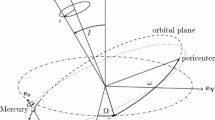Abstract
More than 635 thousand positional observations of planets and spacecraft of various types (mostly radiotechnical ones, 1961–2010) were used to estimate possible changes in the gravitational constant, Sun’s mass, and semi-major axes of planetary orbits, as well as the associated value of the astronomical unit. The observations were analyzed based on the EPM2010 ephemerides constructed at the Institute of Applied Astronomy (Russian Academy of Sciences) in a post-Newtonian approximation as a result of simultanious numerical integration of the equations of motion of nine major planets, the Sun, the Moon, asteroids, and trans-Neptunian objects. The heliocentric gravitational constant GM ⊙ was found to vary with a rate of (GṀ ⊙/GM ⊙ = (−5.0 ± 4.1)) × 10−14 per year (at the 3σ level). The positive secular changes in the semimajor axes ȧ i /a i were found for Mercury, Venus, Mars, Jupiter, and Saturn provided by high-precision observations. These changes also correspond to the decrease in the heliocentric gravitational constant. The changing of GM ⊙, itself is probably caused by the loss of the mass M ⊙ of the Sun due to its radiation and solar wind; these effects are partly compensated by the material falling onto the Sun. Allowing for the maximum bounds on the possible change in the Sun’s mass M ⊙, it has been found from the change obtained in GM ⊙ that the annual change Ġ/G of the gravitational constant G falls within the interval −4.2 × 10−14 < ȧ/G < +7.5 × 10−14 with a 95% probability. The astronomical unit (AU) is connected by its definition only with the heliocentric gravitational constant. The decrease of GM ⊙ obtained in this paper should correspond to a secular decrease in the AU. It is shown, however, that the modern level of accuracy does not allow us to determine a change in the AU. The attained posibility of determining changes in GM ⊙ using high-accuracy observations encourages us to have a relation between GM ⊙ and the AU fixed for a certain moment in time, since it is inconvenient to have a time-dependent length for the AU.
Similar content being viewed by others
References
Bailey, M.E., Chambers, J.E., and Hahn, G., Origin of Sungrazers—A Frequent Cometary End-State, Astron. Astrophys., 1992, vol. 257, no. 1, pp. 315–322.
Brandt, J.C., Introduction to the Solar Wind, San Francisco: Freeman, 1970; Moscow: Mir, 1973.
Brun, A.S., Turck-Chieze, S., and Morel, P., Standard Solar Models in the Light of New Helioseismic Constraints. I. The Solar Core, Astrophys. J., 1998, vol. 506, issue 2, pp. 913–925.
Carroll, B.W. and Ostlie, D.A., An Introduction to Modern Astrophysics, Benjamin Cummings, 1996.
Dirac, P.A.M., A New Basis for Cosmology, Proc. Roy. Soc. L. A, 1938, vol. 165, no. 921, pp. 199–208.
Farinella, P., Froeschle, Ch., Gonzi, R., et al., Asteroids Falling onto the Sun, Nature, 1994, vol. 371, pp. 314–317.
Fizika kosmosa (Space Physics), Syunyaev, R.A., et al., Eds., Moscow: Sov. entsiklopediya, 1986.
Frohlich, C. and Lean, J., The Sun’s Total Irradiance: Cycles, Trends and Related Climate Change Uncertainties Since 1976, Geophys. Res. Lett., 1998, vol. 25, pp. 4377–4380.
Frohlich, C. and Lean, J., Solar Radiative Output and Its Variability: Evidence and Mechanisms, Astron. Astrophys. Rev., 2004, vol. 12, pp. 273–320.
Gel’gaft, B.E., Asymptotic Behavior of the Problem Solution on Two Bodies with Variable Mass, Trudy Astrofiz. Inst. AN KazSSR, 1965, vol. 5, pp. 191–204.
Gladman, B.J., Migliorini, F., Morbidelli, A., et al., Dynamical Lifetimes of Objects Injected into Asteroid Belt Resonances, Science, 1997, vol. 277, pp. 197–201.
Hundhausen, A.J., Coronal Expansion and Solar Wind, Berlin, Heidelberg, New York: Springer-Verlag, 1972; Moscow: Mir, 1976.
Hundhausen, A.J., Coronal Mass Ejections, in Cosmic Winds and the Heliosphere, Jokipii, J.R., Sonett, C.P., Giampapa, M.S., Eds., Tucson: Univ. Arizona Press, 1997, pp. 259–296.
Jeans, H., Cosmogonic Problems Associated with a Secular Decrease of Mass, Mon. Notic. Roy. Astron. Soc., 1924, vol. 85, p. 22.
Jeans, H., The Effect of Varying Mass on Binary System, Mon. Notic. Roy. Astron. Soc., 1925, vol. 85, pp. 912–914.
International Astronomical Union (IAU), Proc. 16th General Assembly, Trans. IAU, 1976, vol. 17(31), pp. 52–66.
Kallenrode, M.-B., Space Physics: An Introduction to Plasmas and Particles in the Heliosphere and Magnetospheres, Berlin: Springer, 2004.
Kevorkian, J.K. and Cole J.D., Multiple Scale and Singular Perturbation Methods, New York: Springer, 1996.
Krasinsky, G.A. and Brumberg, V.A., Secular Increase of Astronomical Unit from Analysis of the Major Planet Motions, and Its Interpretation, Celest. Mech. Dyn. Astron., 2004, vol. 90, pp. 267–288.
Krasinsky, G.A. and Vasilyev, M.V., ERA: Knowledge Base for Ephemeris and Dynamical Astronomy, Proc. 165th IAU Coll. 165, Poznan, 1997, pp. 239–244.
Livingston, W.C., Sun, in Allen’s Astrophysical Quantities, Cox, A.N., Ed., New York: Springer-Verlag, 2000, pp. 339–380.
Mann, I., Czechowski, A., Meyer-Vernet, N., et al., Dust in the Interplanetary Medium, Plasma Phys. Control. Fusion, 2010, vol. 52, p. 10.
Marsden, B.G., The Sungrazing Comet Group II, Astron. J., 1989, vol. 98, pp. 2306–2321.
Marsden, B.G., Sungrazing Comets, Ann. Rev. Astron. Astrophys., 2005, vol. 43, pp. 75–102.
Meyer-Vernet, N., Basics of the Solar Wind, Cambridge Univ. Press, 2007.
Miura, T., Arakida, H., Kasai, M., and Kuramata, S., Secular Increase of the Astronomical Unit: A Possible Explanation in Terms of the Total Angular-Momentum Conservation Law, Publ. Astron. Soc. Jpn., 2009, vol. 61, no. 6, pp. 1247–1250.
Nyambuya, G.G., Azimuthally Symmetric Theory of Gravitation—I. On the Perihelion Precession of Planetary Orbits, Mon. Notic. Roy. Astron. Soc., 2010, vol.403, pp. 1381–1391.
Pitjeva, E.V., High-Precision Ephemerides of Planets-EPM and Determination of Some Astronomical Constants, Solar Syst. Res., 2005, vol. 39, no. 3, p. 176.
Pitjeva, E.V. and Standish, E.M., Proposals for the Masses of the Three Largest Asteroids, the Moon-Earth Mass Ratio and the Astronomical Unit, Celest. Mech. Dyn. Astron., 2009, vol. 103, pp. 365–372.
Pitjeva, E.V., EPM Ephemerides and Relativity, in Proc. 261st IAU Symp. Relativity in Fundamental Astronomy, Klioner, S., Seidelmann, P.K., and Soffel, M., Eds., Cambridge Univ. Press, 2010a, pp. 170–178.
Pitjeva, E.V., Influence of Asteroids and Trans-Neptunian Objects on the Motion of Major Planets and Masses of the Asteroid Main Belt and the TNO Ring, Proc. Int. Conf. “Asteroid-Comet Hazard-2009”, St. Petersburg: Nauka, 2010b, pp. 237–241.
Poincaré, H., Lecons sur les hypothéses cosmogoniques, Paris: Gauthier-Villars, 1911.
Polyakhova, E.N., Celestial Mechanics Aspects for the Problems on Two and Three Bodies with Variable Masses, Uchen. Zapiski LGU. Ser. Mat. Nauki. Trudy Astron. Obs., 1989, vol. 42, no. 424, pp. 104–143.
Sekanina, Z. and Chodas, P.W., Fragmentation Hierarchy of Bright Sungrazing Comets and the Birth and Orbital Evolution of the Kreutz System. II. The Case for Cascading Fragmentation, Astrophys. J., 2007, vol. 663, pp. 657–676.
Uzan, J.-Ph., The Fundamental Constants and Their Variation: Observational and Theoretical Status, Rev. Mod. Phys., 2003, vol. 75, pp. 403–455.
Uzan, J.-Ph., Fundamental Constants and Tests of General Relativity—Theoretical and Cosmological Considerations, Space Sci. Rev., 2009, vol. 148, pp. 249–265.
Williams, J.G., Turyshev, S.G., and Boggs, D.H., Progress in Lunar Laser Ranging Tests of Relativistic Gravity, Phys. Rev. Lett., 2004, vol. 93, p. 5.
Author information
Authors and Affiliations
Additional information
Original Russian Text © E.V. Pitjeva, N.P. Pitjev, 2012, published in Astronomicheskii Vestnik, 2012, Vol. 46, No. 1, pp. 81–90.
Rights and permissions
About this article
Cite this article
Pitjeva, E.V., Pitjev, N.P. Changes in the Sun’s mass and gravitational constant estimated using modern observations of planets and spacecraft. Sol Syst Res 46, 78–87 (2012). https://doi.org/10.1134/S0038094612010054
Received:
Published:
Issue Date:
DOI: https://doi.org/10.1134/S0038094612010054




